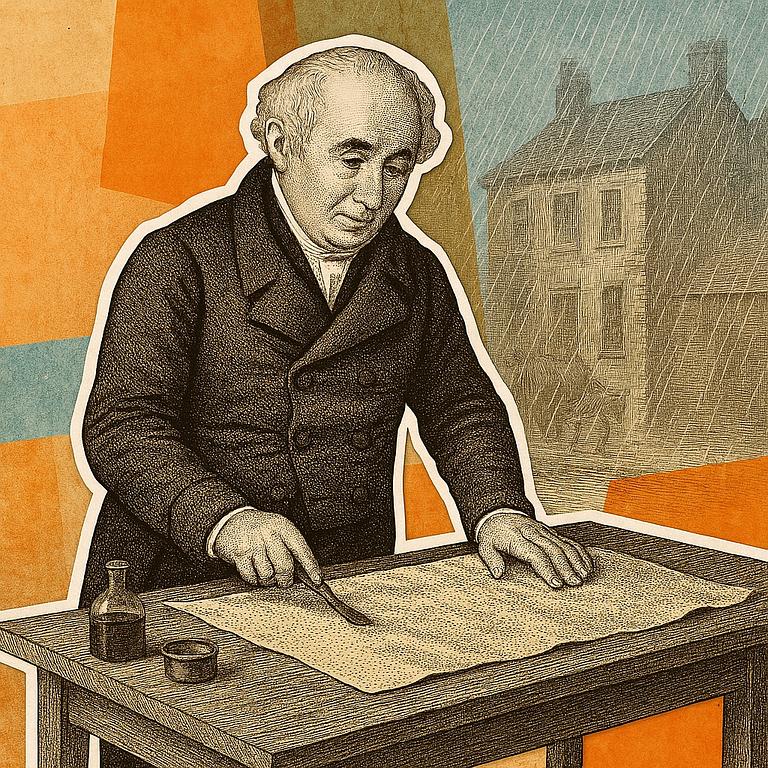
Adam Howell
March 02, 2025
4 mins read
Charles Macintosh and his side project: Waterproof fabric

Day Job: Industrial Chemist and Manufacturing Innovator
Born in 1766 to a family of dye manufacturers, Macintosh studied under renowned chemist Joseph Black at the University of Edinburgh in Scotland before returning to Glasgow to apply his knowledge in Scotland's booming textile industry.
His career breakthrough came in his twenties when he partnered with Charles Tennant to develop a transformational bleaching powder that transformed textile production. This early success provided the financial security that allowed him to pursue his scientific curiosity beyond his primary business.
As owner of his own chemical works in Glasgow, Macintosh built a reputation as both a practical problem-solver and scientific innovator. His contributions to industrial chemistry earned such respect that in 1823, he was elected a Fellow of the Royal Society, Britain's premier scientific organization.
Side Project: Turning Industrial Waste into Waterproof Wonder
When Glasgow's streets began using gas lamps in the 1810s, Macintosh's curiosity was piqued by the messy byproduct others considered a nuisance: coal tar. In his personal laboratory after business hours, he discovered that one of its components, naphtha, could dissolve rubber into a workable solution.
His breakthrough came during an evening experiment when he painted this rubber solution onto wool fabric and pressed another layer on top. As the naphtha evaporated, it created a waterproof barrier between the layers that effectively repelled rain. Recognizing the commercial potential, Macintosh patented his process in 1823 for "rendering the texture" of fabric impervious to water.
When tailors proved reluctant to work with his unconventional material—which stiffened in cold, turned sticky in heat, and carried a distinctive odor—Macintosh refused to let his invention languish. He established dedicated raincoat manufacturing operations in Glasgow and later Manchester, England, overseeing production and continuously refining his process.
His validation arrived when Arctic explorer Sir John Franklin took Macintosh's waterproof canvas on his 1825 expedition. As Franklin reported: "The waterproof canvas proved invaluable for protecting our supplies from the harsh conditions." This real-world endorsement helped secure contracts from the British Army for waterproof coats and capes.
How He Did It: Driven by Curiosity and Practical Problem-Solving
Macintosh balanced his successful primary career with experimental work through a combination of financial freedom and focused determination. His early success with bleaching powder provided the means to pursue passion projects without immediate commercial pressure.
He established a personal laboratory where he could experiment during evenings and weekends, keeping his innovative work separate from his day-to-day chemical business. Rather than pursuing theoretical research, Macintosh focused on practical applications that could solve real-world problems he observed in rainy Glasgow.
When faced with competition from Thomas Hancock in 1830, instead of wasting energy on legal battles, Macintosh merged their companies. This strategic partnership brought in Hancock's "masticator" technology—a machine that recycled scrap rubber into a more workable form—improving their manufacturing process and product quality.
As Thomas Hancock later observed, "Macintosh possessed that rare combination of scientific knowledge and commercial instinct. Where others saw coal tar as a nuisance, he recognized untapped potential."
Legacy: More Than Just a Coat
Nearly two centuries later, Macintosh's name—albeit misspelled as "Mackintosh"—remains synonymous with waterproof outerwear. His innovation laid the groundwork for modern rainwear technology while demonstrating that industrial waste could contain overlooked value.
From his first experiments until his death at age 76 in 1843, Macintosh never stopped refining his waterproofing methods, turning what began as evening curiosity into his defining legacy. The mackintosh coat stands as testament to the power of side projects—and a reminder that our most significant contributions can emerge from work pursued simply because we're curious enough to see potential where others see waste.
About the Author

Adam Howell
Author of the upcoming book "Side History: 101 Side Projects and the Stories of the Men and Women Behind Them". I ❤️ side projects.